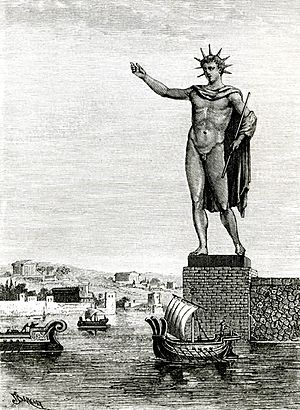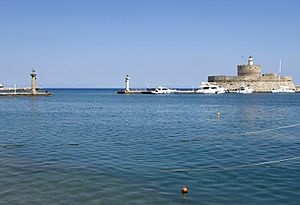Colossus of Rhodes facts for kids
The Colossus of Rhodes was a huge statue of the Greek sun god Helios. It was built on the Greek island of Rhodes by Chares of Lindos in 280 BC. This amazing statue was one of the Seven Wonders of the Ancient World.
It was built to celebrate Rhodes' victory over a powerful ruler named Antigonus I Monophthalmus. His son had tried to attack Rhodes in 305 BC but failed. The Colossus stood about 33 metres (108 feet)* tall. This is almost as tall as the Statue of Liberty from its feet to its crown! It was the tallest statue in the ancient world. Sadly, an earthquake in 226 BC destroyed it, and it was never rebuilt.
In recent years, there have been ideas to build a new Colossus in Rhodes. However, no one is sure exactly where the original statue stood.
Contents
Building the Giant Statue
Building the Colossus started in 292 BC. Ancient stories say it was made with strong iron bars. These bars held brass plates that formed the statue's outer skin. The inside of the statue was filled with stone blocks as it grew taller.
The statue stood on a 15-metre (49-foot)* tall white marble pedestal. Some sources say it was near the Mandraki harbor entrance. Other stories suggest it was on a breakwater in the harbor. The statue itself was about 33 metres (108 feet)* tall.
Much of the iron and bronze used came from weapons left behind by the defeated army. A large siege tower that the enemy abandoned might have been used as scaffolding. This helped workers build the lower parts of the statue.
For the upper parts, workers built a huge earthen ramp. They piled up mounds of earth around the statue as it got taller. Once the statue was finished, all the earth was removed. The Colossus then stood alone, a magnificent sight. The entire project took twelve years to complete, finishing in 280 BC.
How the Colossus Fell
The Colossus stood proudly for 54 years. Then, in 226 BC, a powerful earthquake hit Rhodes. This earthquake caused a lot of damage to the city. The harbor and many buildings were destroyed. The giant statue broke at its knees and crashed to the ground.
Ptolemy III, a ruler from Egypt, offered to pay to rebuild the statue. However, the people of Rhodes were worried. The oracle of Delphi made them believe they had upset the sun god Helios. So, they decided not to rebuild it.
The broken pieces of the statue lay on the ground for over 800 years. Even in ruins, the Colossus was incredibly impressive. Many people traveled just to see its fallen parts. Pliny the Elder, a famous writer, said that few people could even wrap their arms around its fallen thumb. He also noted that each of its fingers was bigger than most statues!
Modern Ideas for a New Colossus
In 2008, there were reports about plans for a new Colossus. A German artist named Gert Hof wanted to build a giant light sculpture. It would be partly made from melted-down weapons from around the world.
In 2015, a group of European architects announced new plans. They wanted to build a modern Colossus that would stand over two piers at the harbor entrance. This new statue would be 150 metres (490 ft) tall. That's five times taller than the original! It would also include a cultural center, a library, and a lighthouse. These would be powered by solar panels. However, these plans were never carried out, and the project's website is no longer active.
Images for kids
-
The Colossus as imagined in a 16th-century drawing by Martin Heemskerck
See also
 In Spanish: Coloso de Rodas para niños
In Spanish: Coloso de Rodas para niños







